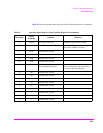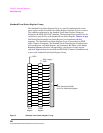
261
Chapter 5, Advanced Operations
Status Reporting
Writing the Enable Register
Syntax
*ESE <integer>
Example
OUTPUT 714;"*ESE 255"
The *ESE command sets the bit pattern (bits 0 through 7) of the Standard Event
Status Enable Register. The Standard Event Status Enable Register allows the
programmer to indicate the occurrence of one or more events (as defined by bits 0
through 7 of the Standard Event Status Register) in bit 5 of the Status Byte
Register.
The bit pattern set by the *ESE command is determined by selecting the desired
event(s) from the Standard Event Status Register, setting the value of the bit
position(s) to a logical one, setting the value of all non-selected bit positions to a
logical zero, and sending the binary-weighted decimal equivalent of bits 0 through
7 after the *ESE command. For example, if the programmer wished to have the
occurrence of a Command Error (bit position 5 in the Standard Event Status
Register) and the occurrence of a Query Error (bit position 2 in the Standard Event
Status Register) to be reflected in bit 5 of the Status Byte Register, the binary-
weighted decimal value of the bit pattern for the Standard Event Status Enable
Register would be determined as follows:
Example
OUTPUT 714;"*ESE 36"
The decimal value of the bit pattern must be a positive integer in the range of 0 to
255. Sending a negative number or a number greater than 255 causes an
HP-IB Error: -222 Data out of range.
Clearing the Enable Register
The ENABLE register is cleared by writing to it with an integer value of zero.
Bit Position
7 65 43210
Logical Value
0 01 00100
Binary
Weighting
1286432168421
Decimal Value
0 +0 +32 +0 +0 +4 +0 +0 = 36


















